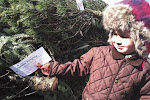We celebrated our son’s second birthday the other day and I went out to the garage freezer to get some ice cream. I found gooshy boxes of ice cream, partially thawed meats and one huge mess of the resulting horrifying liquid rapidly fanning out across the concrete floor.
Who was to blame? I had, as far as I had known, been the last to get something from the freezer and I must have not completely shut the door. It must have been my fault, and, based upon the less-than-pleased response my wife had regarding the situation, she seemed to agree with that conclusion. Further investigation, however, yielded some different results. I asked my three-year-old daughter if she had been in the freezer recently and her response was, “I tried to get the ice cream out but I couldn’t reach it.” Hmmmmmm…
When something goes wrong, people are usually looking for someone to blame. Such is the case with water quality, particularly in the notorious Grand Lake St. Marys Watershed in western Ohio. The result has, unfortunately, led to finger pointing at agriculture in the watershed.
“We’re 3 miles from the lake and we live on a major state highway, so people watch us pretty closely,” said Lou Brown, who runs Brownhaven Dairy with his brother Alan. “The town people are very upset about farmers polluting their lake and they will tell you about it.”
But rather than trying to dodge the blame (whether it is right or wrong), Brown and other farmers are taking extensive measures to eliminate the potential for water pollution from their farms. In fact, rather than avoiding all of the unwanted attention directed at animal agriculture in the area, Brown welcomes the scrutiny as a chance to shine.
“I want people to come and see and learn about what we are doing here,” he said. “We want to do everything we can to be good stewards of the land.”
Brown’s parents purchased the farm in 1959, which now includes 230 acres of corn and alfalfa for feeding the 210-cow dairy. The Browns have a long history of cooperating with neighbors, the community and government conservation programs, including the Environmental Quality Incentives Program (EQIP) and the Conservation Reserve Program (CRP). Every acre of the land the Browns manage has been carefully assessed to determine the best land use to maximize production while minimizing environmental impact.
One example of this philosophy is the wetland that was installed on the farm through CRP four years ago. The commonsense measure turned a losing proposition in terms of production into a win for the surrounding farm fields and the environment. Instead of paying the same high inputs for their less productive ground, the wetland diverts excess water from their fields at planting time and eliminates some of the crop damage from the wildlife.
In addition, they installed 34 acres of 200-foot wide buffer strips along all the roads and ditches from which they are permitted to make hay. They also installed 2 acres of quail habitat in the lower-yielding land along the woods to prevent any crop inputs from leaving the field through surface water. Other than nitrogen applied at corn planting, all of the nutrients on the farm come from manure applications.
Brown closely adheres to the tight manure application regulations and plants cover crops on the farm that further reduce runoff and nutrient loss, improve water infiltration and benefit the soil. Other efforts for water quality management on the farm include the four tile stops on the four large tiles that leave the property.
“We can completely shut off the drainage tiles leaving this farm,” Brown said. “We shut them off every time we apply manure and after the crop is planted so we can conserve moisture and boost our yields. And you can visually inspect easily to make sure your manure is not going anywhere.”
The truth about the problems in the Watershed is that the situation is extremely complex and the actual blame is tough to determine accurately. As a major land use, agriculture is certainly one component of the problem, but not the only one. And, with more farmers like Brown taking measures to address the situation, improvements will occur.
“This part of Auglaize County has been really gung ho about adopting all of these practices,” Brown said. “We are not the only ones doing all of these things out here and it has to be making a difference in the lake.”
If things do not improve, maybe there needs to be further investigation in the blame game of Grand Lake St. Marys.

No comments:
Post a Comment